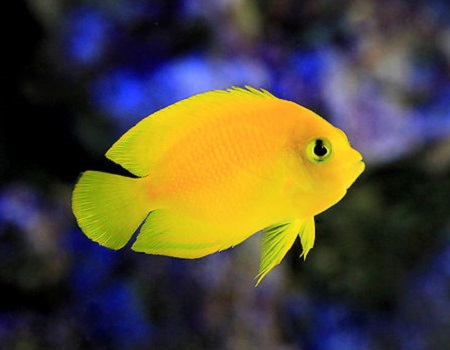Identification:
The Yellow Angelfish are easy to care, very hardy and generally good eaters. They will take all manner of offered foods and graze on hair algae on live rock. They require a mature tank that is a minimum of 70 gallons with plenty of live rock and algae growth. Place the rock work with multiple places to hide so they will feel secure enough to come out often. This will provide security, and the more secure it feels, the more it will come out into the open. The Yellow Angelfish (Centropyge heraldi) is also known as the Herald's Angelfish, Heraldi Angelfish or False Lemonpeel Angelfish. The Yellow Angel has a fluorescent yellow body and is often mistaken by the novice for the close resembling cousin the Lemonpeel Angelfish (Centropyge flavissima) with the exception of not having the blue markings around the eyes and the edges of the fins. The Yellow Angel can be extremely aggressive towards its own species and towards fish with similar coloration or shape, especially the Lemonpeel Angelfish (Centropyge flavissima). It will do well in a community aquarium with peaceful or semi-aggressive fish as long as it is added close to last.
The Yellow Angelfish require lots of hiding places in a rocky Aqua-scaped aquarium with lots of caves/crevices and ample amounts of live rock for grazing on microalgae and diatoms. While they should not harm non-sessile invertebrates such as shrimp, snails or crabs. They may occasionally nip at SPS corals and some species of polyp corals, zoanthids, and clam mantles. Although, if you start with a younger angel, say a small or medium, and they are well fed on a diet of Spirulina, marine algae, high-quality angelfish preparations, mysis or large chunks of raw meaty frozen shrimp, squid, clam, and mussels they tend not to bother corals too much.
All Yellow Angels are born female and can be paired according to size, not necessarily color. The larger fish becomes male, so making a pair is possible by buying a larger Yellow Angel and a smaller one, and within a few months hopefully they will assume their roles as male and female. Dwarf angelfish will spawn in captivity and some are now being raised, yet raising the larvae is quite a difficult task.
Food and Diet:
Dwarf Angelfish are omnivore's. In the wild it feeds primarily on algae, but it will also ingest tiny animals living in the algae. In captivity their diet will be mostly algae, but also offer some other proteins. Feeding them a variety of good foods is important. Offer various types of fresh and dried marine algae, spirulina enriched foods, mysis shrimp, shaved shrimp and other high-quality meaty foods, angelfish preparations, and flakes or pellets designed for algae eating fish. There are several good commercial foods available including Formula II and Angel Formula. Feed several times a day even if natural foods are present.
Recommended amount of drip acclimation time:
3+ hours
Approximate Purchase Size:
Small: .75" to 1"; Medium: 1" to 2"; Large: 2" to 3"; XLarge: 3" to 4"
|



